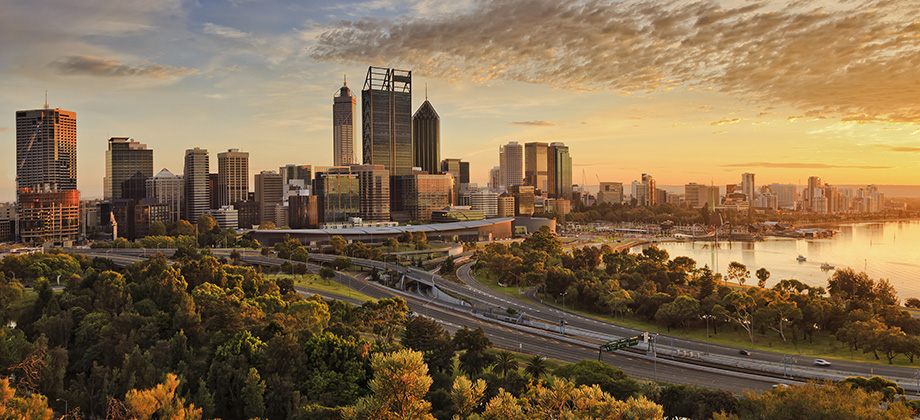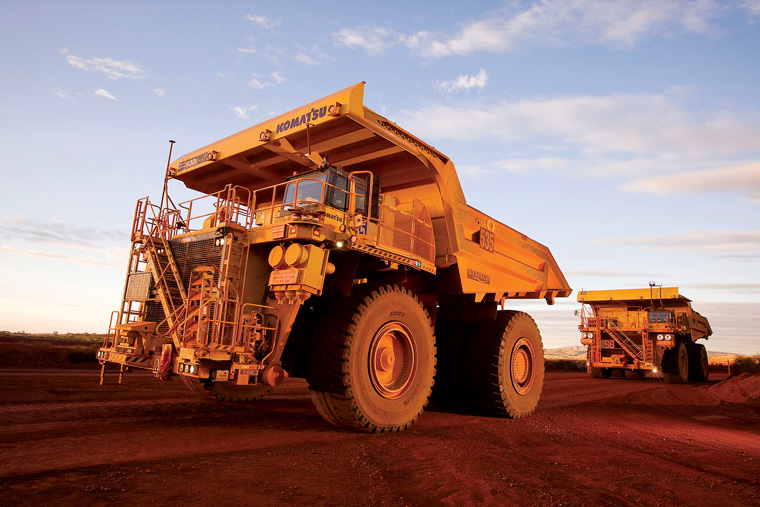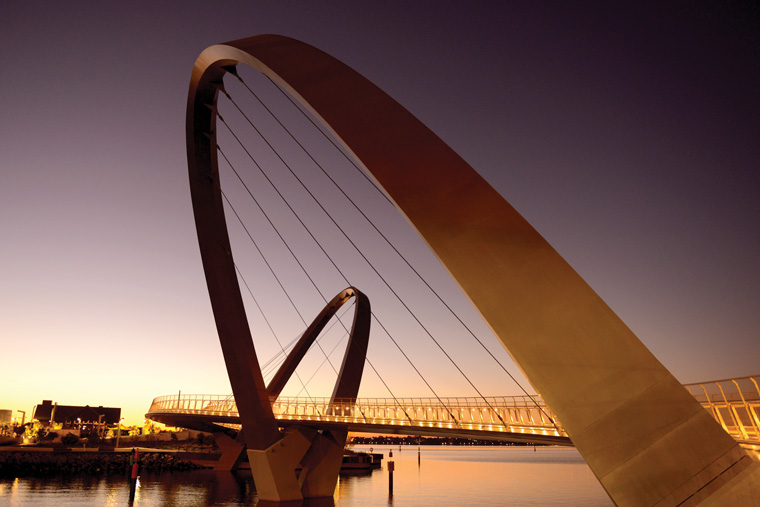From Gold Rush to Big Data
While Western Australia has long been a resource industry-based economy, recent moves have led to a more diversified economy, with tourism, agriculture and high-tech innovation flourishing.

With more than a century of statehood now under its belt, Western Australia (WA) has moved from being one of the country’s more remote outposts to one of its leading economic centres, home to more publicly listed companies than any other city in Australia.
Its capital, Perth, is now Australia’s fourth largest city, with a population of over two million, while its mining and gas sectors are responsible for 43% of the whole country’s exports.
Some 37% of global iron ore production, 13% of world alumina production, 6% of the world’s gold output and 9% of its liquefied natural gas (LNG) output also all come from WA.
The state is now a leading agricultural centre, too, exporting A$1.7 billion of barley, wool, canola, mutton, oats and wine to China alone in 2015. Recent times have seen the state also carve out a niche for higher-end, high quality fruit and vegetables, stamping a local label on supermarket shelves from Beijing to Berlin.
All this has been achieved, too, not only in a remarkably short space of time, but by remarkably few people in a remarkably giant landscape.
WA is the size of Europe, yet has a population of just 2.6 million, of whom the vast majority live in the Perth-Fremantle area, down on the southwestern coast.
This development has also been achieved despite a long-standing dependence on the notoriously cyclical commodities cycle, with natural resources by far WA’s largest industry.
Now, on the downslope of that cycle, the state is also having to cope with the inevitable completion of some of the resource sector’s enormous investment projects. Indeed, as the key mining and gas industries now move from that investment phase to an output phase, WA finds itself having to pivot towards new sectors and innovative approaches to sustain its development.
Signs are though, the state’s hard-working, can-do attitude and well-educated workforce are well equipped to take WA on to the next level.

Gold Rush to Investment Rush
WA’s modern economy really started to take off in the late 19th century, when the state ¬– back then little more than the settlements of Fremantle, Perth and Guildford – was hit by a flood of prospectors, heading inland for a series of gold rushes.
Discoveries had been made in the northern Kimberley, southern Kalgoorlie and mid-Western Murchison districts.
All three of these are still key amongst WA’s nine administrative regions, too.
The Kimberley contains mines, offshore gas and oil, and a major agricultural area in the Ord River. Kalgoorlie, meanwhile, in the Goldfields-Esperance region, is still home to the ‘Golden Mile’, one of the world’s richest gold seams.
Meanwhile, although the mining industry has largely departed Murchison, in the Mid-West region, the place is now symbolic of a new WA. Since 2012, the region has been home to the Australian Square Kilometre Array (SKA) radio telescope, a major development in forging WA’s new, high-tech profile.
Indeed, the mining industry in WA itself has become one of the world’s most technologically sophisticated, using state-of-the-art IT to overcome some of the giant state’s major logistical challenges.
In the Kimberley and in neighbouring Pilbara, companies such as Rio Tinto and BHP Billiton have invested in robot trains, trucks and remote control centres that have revolutionised the trade. Nowadays, grizzly, gold rush prospectors have been replaced by air-conditioned control centres, running mining operations from thousands of kilometres away to the south.
People Power
One major driving force behind this technological advancement has also been one of the state’s major bugbears – the basic shortage of one vital commodity: people.
“The number one thing that WA has, perhaps, been challenged by, is the critical mass in population,” says Justin Carroll, Managing Partner of PwC Perth.
The boom and bust times of the gold rush were followed by a surge in demand for iron ore from the US, then wartime depression and post-World War II recovery. Each time the cycle spun, however, bringing people in to work on the new industry, keeping them in the state for the next wave has been a major challenge.
Indeed, WA’s population languished in the hundred-thousands for many years, while the Australian east coast continued to attract most new arrivals. It wasn’t until the early 1970s that the population of the whole state passed the one million mark.
Automation thus became one way to handle this shortage, which was further compounded by the fact that the mining was largely in remote areas of the north, far from the cities in the southwest where people wanted to live. In addition, there were the relatively high wages that labour in a developed-world economy commanded.
The state thus became used to acronyms like FIFO – ‘fly-in, fly-out’ – to describe its workers, as it slowly built up that population ‘critical mass’.
Into the Air
Major take-off time finally came in the new century, when the resources cycle went into high gear again – this time thanks to events far to the north.
“The latest cycle was evidently a super cycle,” says WA State Premier and Tourism Minister Colin Barnett, “brought about by a one-off event – the rapid development and rise in living standards of hundreds of millions of people in China.”
Indeed, Asia has been the name of the Western Australian economic game for many years, now.
“We are more connected to Asia than any other part of Australia when it comes to the volume of business” Barnett adds.
The huge advantage WA has had in this, as John Atkins, WA’s Agent General in London, points out, is that nowadays, “One hour either side of WA’s time zone is 60% of the world’s population and 40% of the world’s GDP.” The state also has “very, very good relationships with China and Japan”.
The huge rise in demand from China, along with other emerging markets in Asia, has meant an apparently insatiable appetite for WA’s minerals and gas. Huge investments into the resources sector have followed.
“We’ve had about A$600 billion invested in resource developments over the last 10 years,” says WA Treasurer, Mike Nahan.
The existing reputation for high-tech extraction also stood WA in good stead for this, with spin-offs boosting other areas of the economy.
“One of the fantastic things about the resource sector is that as an industry, we touch many other sectors – from aviation to medicine, construction, IT, it goes on,” says Nev Power, CEO of Fortescue Metals Group.
The SKA, the Pawsey supercomputer, leading developments in solar and wave power, and a string of tech start-ups and smart city initiatives are all connected to this original, resources technology base.

New Maturity
The resource boom saw WA’s gross state product (GSP) grow an average 5% for over 15 years. This extraordinary expansion also helped fund an infrastructure boom. Indeed, the original gold rush worked in much the same way, with the state’s first water pipeline being laid, from Perth to Kalgoorlie, as a consequence. To put the gold rush era pipeline into context, the cost was more than the state’s entire annual budget at the time. Nowadays, it’s roads, railways, airport expansions and port facilities that have followed in resources’ wake.
Moreover, there has been a major new investment in the social and cultural infrastructure, as well as in agriculture, which has come back as a major string to WA’s economic bow.
Yet, resources is a notoriously cyclical business, with the recent China-led boom no exception – even if its peaks were.
The last few years have seen prices slump, along with demand, while LNG has hit a supply glut, as a rash of new projects have come on line. At the same time, the investment phase for many of the new resources projects in the state has largely ended, with the output phase beginning. This means less demand for workers in the sector, and a negative ‘ripple effect’ on services companies operating around the minerals and hydrocarbons industries.
A state-wide downturn has been the inevitable result, with the impact visible in the State Final Demand (SFD) figures. Combining together household, business and government expenditure and investment, the first half of 2016 has seen SFD shrinking, meaning many ordinary Western Australians are undoubtedly feeling the pinch.
What is surprising this time, however, is that the ‘down’ is nowhere near as major as the previous ‘up’ – a sign of the economy’s growing maturity.
“In the boom,” says Nahan, “yes, we went up, but this ratcheted up the productive capacity of WA and the demand for investment and jobs going forward.”
GSP has thus continued to grow – and at a rate higher than the Australian average. Resources companies have also continued to make major profits, even if they have also been obliged to restructure.
The downturn has given greater impetus to WA’s efforts to diversify, too. A greater emphasis is now being given to agriculture, tourism and high-tech industries, as well as education. Construction is also turning from building LNG plants to boutique hotels and waterfront apartments in Perth and Fremantle.
“Things are now changing quickly,” says Barnett. “One of the other things that I’ve done as Premier is put big, public investment into our capital city.”
Indeed, the Perth area is now home to a major slew of urban regeneration projects, masterminded by the Metropolitan Redevelopment Authority (MRA).
Many of these, such as Elizabeth Quay, the Perth City Link and Riverside, aim to pull people into the long-neglected downtown. This is key to building density in what is now a well spread-out city, with this in turn part of creating the ecosystem for a cultural and social infrastructure that will keep the ‘critical mass’ building, despite the economic downturn.
Education too has a role to play here, with the University of Western Australia, Curtin University and Notre Dame in Fremantle all helping to raise the cultural bar for the state – as well as bringing in more students and R&D investment.
Going full circle, the latter is also vital for that original staple of the state’s economy – resources.
As that sector becomes more automated, business is working with the universities and government in order to create an understanding that there is a much greater need for people focused on science, technology, engineering and mathematics.
The future for WA, then, may still be one based on iron ore, alumina, LNG and gold. But it will be the computer grads of the state’s universities who will be dominating that trade, along with many other industries. Meanwhile, a new, more service-based economy will be taking on its critical mass, making WA an increasingly attractive and globally high-profile investment destination.


















